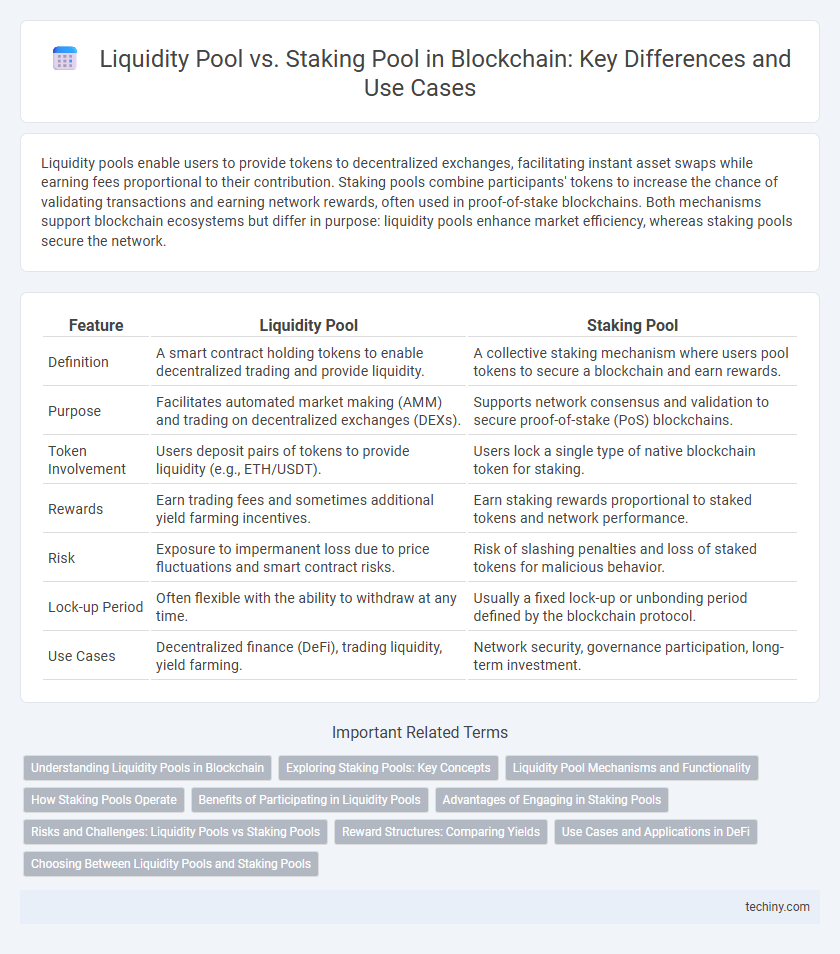Liquidity pools enable users to provide tokens to decentralized exchanges, facilitating instant asset swaps while earning fees proportional to their contribution. Staking pools combine participants' tokens to increase the chance of validating transactions and earning network rewards, often used in proof-of-stake blockchains. Both mechanisms support blockchain ecosystems but differ in purpose: liquidity pools enhance market efficiency, whereas staking pools secure the network.
Table of Comparison
| Feature | Liquidity Pool | Staking Pool |
|---|---|---|
| Definition | A smart contract holding tokens to enable decentralized trading and provide liquidity. | A collective staking mechanism where users pool tokens to secure a blockchain and earn rewards. |
| Purpose | Facilitates automated market making (AMM) and trading on decentralized exchanges (DEXs). | Supports network consensus and validation to secure proof-of-stake (PoS) blockchains. |
| Token Involvement | Users deposit pairs of tokens to provide liquidity (e.g., ETH/USDT). | Users lock a single type of native blockchain token for staking. |
| Rewards | Earn trading fees and sometimes additional yield farming incentives. | Earn staking rewards proportional to staked tokens and network performance. |
| Risk | Exposure to impermanent loss due to price fluctuations and smart contract risks. | Risk of slashing penalties and loss of staked tokens for malicious behavior. |
| Lock-up Period | Often flexible with the ability to withdraw at any time. | Usually a fixed lock-up or unbonding period defined by the blockchain protocol. |
| Use Cases | Decentralized finance (DeFi), trading liquidity, yield farming. | Network security, governance participation, long-term investment. |
Understanding Liquidity Pools in Blockchain
Liquidity pools in blockchain are decentralized pools of tokens locked in smart contracts to facilitate trading on decentralized exchanges (DEXs) by providing liquidity. These pools enable users to trade assets without relying on centralized intermediaries, reducing slippage and improving transaction efficiency. Unlike staking pools, which primarily secure blockchain networks and earn rewards, liquidity pools incentivize participants through trading fees and token rewards for supplying assets.
Exploring Staking Pools: Key Concepts
Staking pools aggregate individual cryptocurrency holdings to increase chances of validating blocks and earning rewards in proof-of-stake networks, providing a more accessible entry point compared to solo staking. Unlike liquidity pools that facilitate decentralized trading by locking tokens in smart contracts to provide market liquidity and earn fees, staking pools prioritize network security and consensus participation. Understanding staking pools involves key concepts such as delegation, reward distribution, slashing risks, and the role of pool operators in maintaining network integrity.
Liquidity Pool Mechanisms and Functionality
Liquidity pools function as decentralized reserves of tokens that enable seamless trading on automated market makers (AMMs) by providing continuous liquidity and price stability. These pools rely on smart contracts to aggregate user deposits, facilitating instant token swaps without traditional order books. By incentivizing liquidity providers with fees and rewards, liquidity pools ensure efficient asset availability and enhanced market efficiency within decentralized finance ecosystems.
How Staking Pools Operate
Staking pools operate by aggregating tokens from multiple holders to increase the chances of validating blocks and earning rewards on proof-of-stake blockchains. Participants delegate their tokens to a pool operator who manages the validation process, distributing rewards proportionally based on the amount staked. This system lowers the barrier for individual users to participate in network consensus and benefit from staking incentives without running a full node.
Benefits of Participating in Liquidity Pools
Participating in liquidity pools offers benefits such as earning transaction fees generated from decentralized exchanges, providing consistent passive income. Liquidity providers facilitate seamless token swaps, enhancing market efficiency and price stability. The ability to withdraw funds anytime without lock-up periods gives ample flexibility compared to staking pools.
Advantages of Engaging in Staking Pools
Staking pools offer enhanced accessibility by allowing participants to combine their resources and meet minimum staking requirements that might be prohibitive individually. These pools provide consistent passive income through staking rewards secured by consensus algorithms such as Proof of Stake (PoS). Risk mitigation is another key advantage, as the collective nature of staking pools distributes potential losses and reduces the impact of individual node failures.
Risks and Challenges: Liquidity Pools vs Staking Pools
Liquidity pools expose users to impermanent loss and smart contract vulnerabilities, potentially reducing asset value during volatile market conditions. Staking pools, while generally offering more stable rewards, carry risks linked to network slashing, validator failures, and lock-up periods that limit liquidity. Both require careful assessment of protocol security, market dynamics, and liquidity constraints to mitigate financial risks effectively.
Reward Structures: Comparing Yields
Liquidity pools offer variable rewards based on trading fees and impermanent loss risks, often resulting in higher but less predictable yields. Staking pools provide more stable, fixed rewards derived from blockchain consensus mechanisms, favoring risk-averse investors. Yield comparison depends on factors such as pool size, token volatility, and protocol incentives within DeFi ecosystems.
Use Cases and Applications in DeFi
Liquidity pools enable decentralized trading and yield farming by allowing users to deposit paired assets and earn transaction fees on automated market makers (AMMs), supporting decentralized exchanges like Uniswap and SushiSwap. Staking pools consolidate tokens from multiple holders to secure networks through consensus mechanisms such as Proof of Stake (PoS), with applications in projects like Ethereum 2.0 and Cardano to earn staking rewards. Both liquidity and staking pools facilitate decentralized finance (DeFi) activities, but liquidity pools prioritize market liquidity and trading efficiency, while staking pools focus on network security and passive income via consensus participation.
Choosing Between Liquidity Pools and Staking Pools
Choosing between liquidity pools and staking pools depends on risk tolerance and yield preference within decentralized finance (DeFi). Liquidity pools offer trading fee rewards and potential impermanent loss, making them suitable for users seeking active market participation and higher returns. Staking pools provide more stable, often lower-risk rewards by locking tokens to support network security or governance, appealing to investors prioritizing steady income and decentralized consensus.
Liquidity Pool vs Staking Pool Infographic

 techiny.com
techiny.com